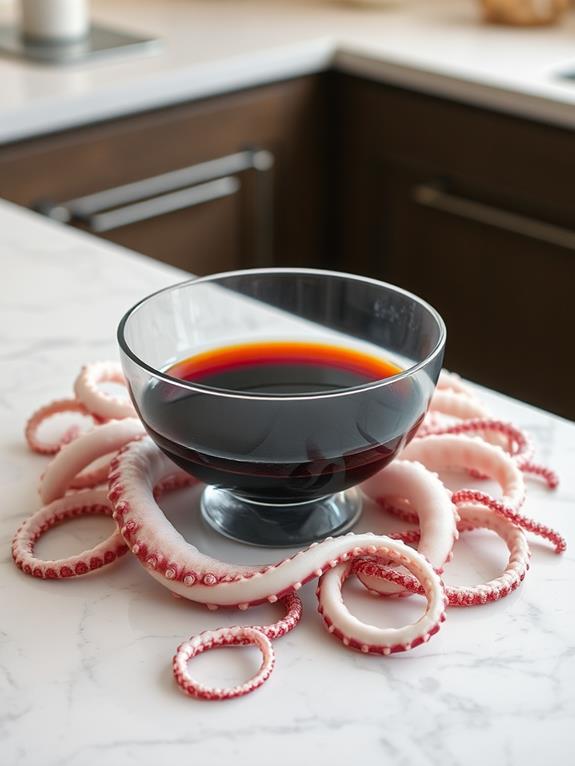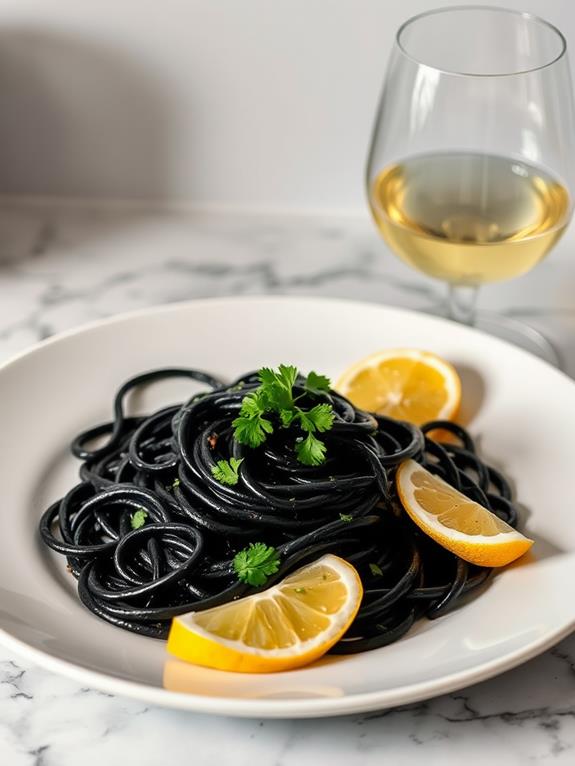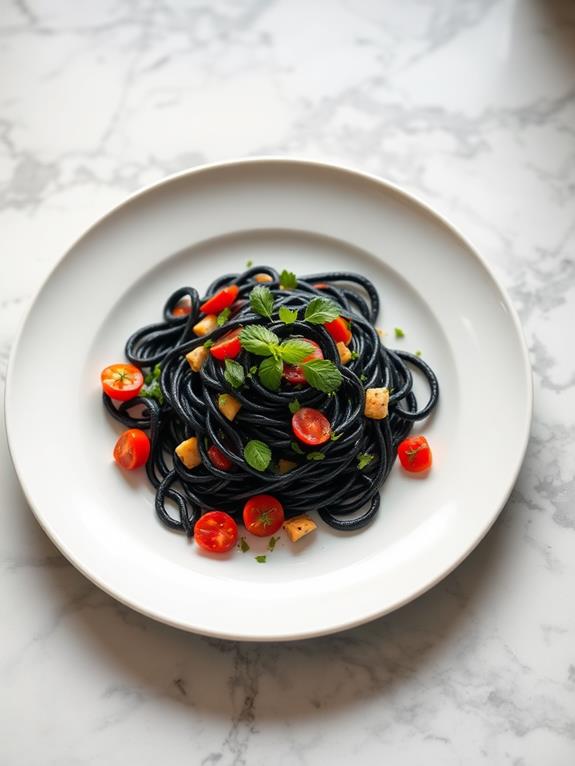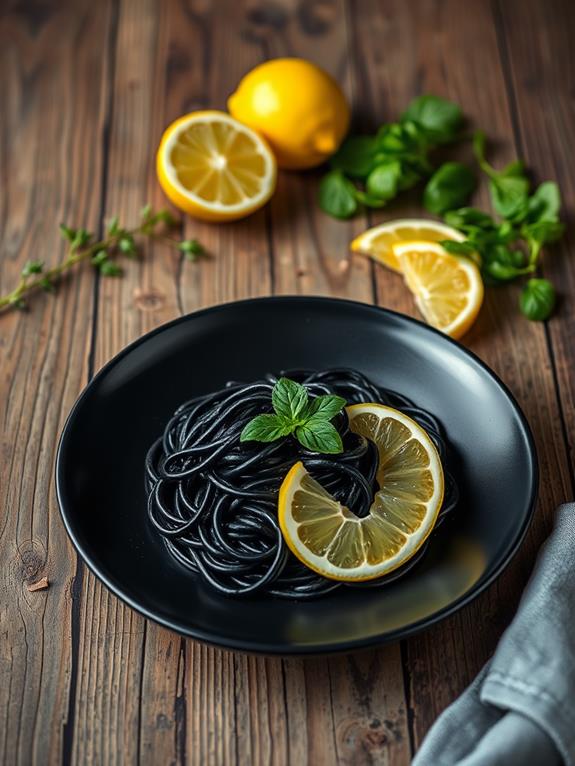Is It Safe to Eat Squid Ink
Squid ink is generally safe to eat when sourced from reputable suppliers. It's composed primarily of melanin and contains amino acids, enzymes, and neurotransmitters, contributing to its unique flavor profile. While allergic reactions are possible for those with shellfish sensitivities, squid ink offers nutritional benefits, including essential minerals and antioxidants. It's widely used in Mediterranean and Asian cuisines, enhancing dishes with its briny taste and acting as a natural dye. The FDA labels squid as a "Best Choice" due to low mercury levels, but monitoring intake is recommended. Squid ink's cultural significance and culinary versatility make it an intriguing ingredient worth exploring further.
This post may contain affiliate links. If you make a purchase through these links, I may earn a commission at no additional cost to you. Additionally, portions of this post may be generated using artificial intelligence (AI) technology. While we strive for accuracy, please be aware that AI-generated content may not always be perfect and should be fact-checked when necessary.
The Spatula Scoops
- Squid ink is generally recognized as safe for consumption when sourced from reputable suppliers.
- Individuals with shellfish allergies should exercise caution due to potential allergic reactions.
- The FDA labels squid as a "Best Choice" due to low mercury levels, but monitoring intake is recommended.
- Squid ink is rich in essential nutrients, vitamins, and minerals, offering potential health benefits.
- Commercial squid ink may pose risks of high sodium levels and heavy metal contamination.
Understanding Squid Ink Composition

For centuries, squid ink has been a mysterious and intriguing substance. If you've ever wondered about its composition and whether it's safe to eat, you're not alone. Squid ink is primarily made up of melanin, the same pigment that gives color to human skin and hair, which is responsible for its distinctive dark blue-black hue.
But there's more to squid ink than just its color. It's packed with amino acids, enzymes, and neurotransmitters that contribute to its unique flavor profile and potential health benefits. These components also play a significant role in the ink's function as a defense mechanism for cephalopods, helping to obscure their visibility to predators.
The nutritional composition of squid ink includes essential minerals like potassium and iron, making it a valuable addition to your diet. Some studies suggest that squid ink may have antimicrobial properties, which could contribute to its potential health benefits. While more research is needed, the presence of trace amounts of catecholamines, such as dopamine, in squid ink might have implications for mood regulation and cognitive function.
Safety and Health Considerations

Safety considerations are paramount when it comes to consuming squid ink. While it's generally recognized as safe food when sourced from reputable suppliers, you should be aware of potential risks. If you have shellfish allergies, you might experience allergic reactions to squid ink due to the presence of tropomyosin, a known allergen. It's vital to exercise caution and consult your doctor if you're unsure. Additionally, much like the palm oil industry, which has significant impacts on local economies, the sustainability of seafood sourcing is essential for health and environmental considerations, reflecting on responsible consumption practices sustainability efforts and regulation.
When incorporating squid ink into your diet, moderation is key. Some commercially prepared inks may contain high sodium levels and potential heavy metal contamination, so it's best to limit your intake. However, preliminary studies have suggested potential health benefits associated with squid ink, including antimicrobial properties. Keep in mind that more research is needed to fully understand its effects on human health.
Regarding your overall seafood intake, the FDA classifies squid as a "Best Choice" for low mercury levels. This makes it a relatively safe option, but you should still monitor your consumption as part of a balanced diet. By being mindful of these safety and health considerations, you can enjoy squid ink responsibly.
Culinary Applications of Squid Ink

Having addressed the safety aspects, let's explore the exciting world of squid ink in the kitchen. You'll find this unique ingredient widely used in Mediterranean and Asian cuisines, where it's prized for its ability to add a briny flavor and striking dark color to dishes. Squid ink is particularly popular in pasta dishes like the Italian spaghetti al nero di seppia and rice-based meals such as Spain's Arroz Negro. Additionally, much like the recipes featured in 100 Simple, Healthy Dinner Recipes, squid ink can be integrated into quick and nutritious meals that appeal to family members of all ages.
What makes squid ink so appealing to chefs is its versatility. It's not just about the visual impact; the ink's high glutamate content contributes to an umami taste, enhancing flavors in sauces and dressings. You'll appreciate how it adds depth without the fishiness often associated with seafood ingredients. This allows for creative culinary experimentation, especially in seafood-based meals.
As a natural dye, squid ink offers a visually stunning alternative to cream-based sauces while keeping sodium content low. Whether you're preparing pasta, rice, or risottos, incorporating squid ink can elevate your dish both in taste and appearance, making it a valuable addition to your culinary toolkit.
Nutritional Profile and Benefits

Ever wondered about the hidden benefits of squid ink beyond its culinary appeal? This unique ingredient isn't just a flavor enhancer; it's packed with nutritional benefits that might surprise you. Squid ink is low in calories but rich in essential nutrients. You'll find it's a great source of melanin, antioxidants, and vitamins, particularly B12 and Vitamin E. In fact, like Navitas Organics Cacao Butter, which is also low-calorie and rich in nutrients, squid ink supports your overall health and well-being. These components contribute to your overall health and well-being.
The ink also contains essential minerals like selenium and iron, which support your immune health and help transport oxygen throughout your body. Its high glutamate content not only gives it that distinctive umami flavor but also provides beneficial amino acids. Research suggests that the antioxidant properties of squid ink may protect you against inflammation and free radical damage, potentially supporting your heart health. Additionally, initial studies have shown that squid ink possesses antimicrobial properties, which may be effective against bacteria contributing to dental plaque and foodborne illnesses. While more research is needed, these findings indicate that squid ink could have applications beyond the culinary world, potentially offering health benefits that extend from your plate to your overall wellness.
Cultural Significance in Cuisine

Beyond its nutritional benefits, squid ink holds a special place in culinary traditions around the world. You'll find it prominently featured in Mediterranean cuisine, where it's used in iconic dishes like paella and arroz negro. These dishes not only showcase the ink's flavor-enhancing properties but also its ability to create visually striking meals. In addition, similar to how a premium Korean stone bowl can elevate dining experiences and dish presentations, squid ink enhances the presentation and appeal of various global dishes.
In Japanese cuisine, you'll encounter squid ink in various sauces and pasta dishes, demonstrating how this ingredient bridges seafood traditions across cultures. Notably, squid ink's significance extends beyond the kitchen. Ancient Greeks recognized its potential in traditional medicine, highlighting its multifaceted role in cultural practices.
You might be surprised to learn that squid ink isn't just for eating. Many societies have harnessed its properties as a natural dye, connecting culinary arts with broader artistic expressions. This versatility has contributed to squid ink's growing popularity in gourmet culinary scenes worldwide.
As you explore global cuisines, you'll notice how squid ink exemplifies the trend of embracing unique, locally-sourced ingredients. Its integration into diverse dishes reflects a celebration of regional flavors and seafood traditions, making it a captivating subject for food enthusiasts and cultural explorers alike.
Frequently Asked Questions
Is Squid Ink Poisonous to Humans?
No, squid ink isn't poisonous to humans. You can safely consume it when sourced from reputable suppliers. It's recognized as a safe food additive and hasn't shown any severe adverse effects under normal dietary conditions. However, if you have seafood allergies, you should be cautious due to proteins like tropomyosin in the ink. While it's not toxic, it's best to consume squid ink in moderation, as improperly processed ink might contain contaminants.
What Does Squid Ink Taste Like?
Ever wondered about the taste of squid ink? You'll find it's a unique flavor experience. It's briny and oceanic, with a rich umami depth that enhances dishes. You'll notice a subtle sweetness alongside its savory notes, thanks to its high glutamate content. When you use squid ink in cooking, it complements seafood beautifully and provides an intriguing contrast to other ingredients. You'll appreciate its ability to add concentrated flavor and striking color to your culinary creations.
What Squid Ink Is Edible?
You can safely consume squid ink from various cephalopod species, including cuttlefish, octopus, and squid. The most commonly used edible ink comes from the European squid (Loligo vulgaris) and the Japanese flying squid (Todarodes pacificus). When purchasing squid ink, verify it's from a reputable source and properly processed for culinary use. Commercial preparations are often available in small sachets or jars. Remember, while all cephalopod ink is technically edible, not all are equally palatable or suitable for cooking.
Does Squid Ink Have Dopamine?
You'd be amazed to learn that squid ink does indeed contain dopamine! This fascinating substance, produced by cephalopods, has trace amounts of this neurotransmitter. While the exact concentration isn't well-documented, dopamine's presence contributes to squid ink's complex biochemical profile. It's garnered interest for potential memory and concentration benefits, though more research is needed. As a natural marine product, squid ink's unique composition, including dopamine, makes it intriguing for both nutritional and culinary applications. Remember, it's always best to consult experts for specific health-related questions.





